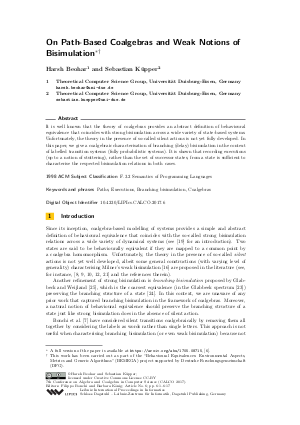On Path-Based Coalgebras and Weak Notions of Bisimulation
Authors Harsh Beohar, Sebastian Küpper
-
Part of:
Volume:
7th Conference on Algebra and Coalgebra in Computer Science (CALCO 2017)
Part of: Series: Leibniz International Proceedings in Informatics (LIPIcs)
Part of: Conference: Conference on Algebra and Coalgebra in Computer Science (CALCO) - License:
 Creative Commons Attribution 3.0 Unported license
Creative Commons Attribution 3.0 Unported license
- Publication Date: 2017-11-17
File

PDF
LIPIcs.CALCO.2017.6.pdf
- Filesize: 0.57 MB
- 17 pages
Document Identifiers
Subject Classification
Keywords
- Paths
- Executions
- Branching bisimulation
- Coalgebras
Metrics
- Access Statistics
-
Total Accesses (updated on a weekly basis)
0PDF Downloads0Metadata Views
Abstract
It is well known that the theory of coalgebras provides an abstract definition of behavioural equivalence that coincides with strong bisimulation across a wide variety of state-based systems. Unfortunately, the theory in the presence of so-called silent actions is not yet fully developed. In this paper, we give a coalgebraic characterisation of branching (delay) bisimulation in the context of labelled transition systems (fully probabilistic systems). It is shown that recording executions (up to a notion of stuttering), rather than the set of successor states, from a state is sufficient to characterise the respected bisimulation relations in both cases.
Cite As Get BibTex
Harsh Beohar and Sebastian Küpper. On Path-Based Coalgebras and Weak Notions of Bisimulation. In 7th Conference on Algebra and Coalgebra in Computer Science (CALCO 2017). Leibniz International Proceedings in Informatics (LIPIcs), Volume 72, pp. 6:1-6:17, Schloss Dagstuhl – Leibniz-Zentrum für Informatik (2017)
https://doi.org/10.4230/LIPIcs.CALCO.2017.6
BibTex
@InProceedings{beohar_et_al:LIPIcs.CALCO.2017.6,
author = {Beohar, Harsh and K\"{u}pper, Sebastian},
title = {{On Path-Based Coalgebras and Weak Notions of Bisimulation}},
booktitle = {7th Conference on Algebra and Coalgebra in Computer Science (CALCO 2017)},
pages = {6:1--6:17},
series = {Leibniz International Proceedings in Informatics (LIPIcs)},
ISBN = {978-3-95977-033-0},
ISSN = {1868-8969},
year = {2017},
volume = {72},
editor = {Bonchi, Filippo and K\"{o}nig, Barbara},
publisher = {Schloss Dagstuhl -- Leibniz-Zentrum f{\"u}r Informatik},
address = {Dagstuhl, Germany},
URL = {https://drops.dagstuhl.de/entities/document/10.4230/LIPIcs.CALCO.2017.6},
URN = {urn:nbn:de:0030-drops-80362},
doi = {10.4230/LIPIcs.CALCO.2017.6},
annote = {Keywords: Paths, Executions, Branching bisimulation, Coalgebras}
}
Author Details
References
-
J. Adámek, F. Bonchi, M. Hülsbusch, B. König, S. Milius, and A. Silva. A coalgebraic perspective on minimization and determinization. In Proc. of FOSSACS '12, pages 58-73. Springer, 2012. LNCS/ARCoSS 7213.

-
P. Alexandroff. Diskrete räume. Rec. Math. N.S., 2(44)(3):501-519, 1937.

-
M. Alvarez-Manilla. Extension of valuations on locally compact sober spaces. Topology and its Applications, 124(3):397 - 433, 2002.

-
C. Baier and H. Hermanns. Weak bisimulation for fully probabilistic processes. In Proc. of CAV, pages 119-130, London, UK, 1997. Springer.

- H. Beohar and P.J.L. Cuijpers. Open maps in concrete categories and branching bisimulation for prefix orders. ENTCS, 319:51 - 66, 2015. URL: http://dx.doi.org/10.1016/j.entcs.2015.12.005.
- H. Beohar and S. Küpper. On path-based coalgebras and weak notions of bisimulation. ArXiv e-prints, May 2017. URL: https://arxiv.org/abs/1705.08715.
-
F. Bonchi, S. Milius, A. Silva, and F. Zanasi. Killing epsilons with a dagger: A coalgebraic study of systems with algebraic label structure. TCS, 604:102 - 126, 2015. Coalgebraic Methods in Computer Science.

- T. Brengos. On Coalgebras with Internal Moves, pages 75-97. Springer, 2014. URL: http://dx.doi.org/10.1007/978-3-662-44124-4_5.
- T. Brengos. Weak bisimulation for coalgebras over order enriched monads. Logical Methods in Computer Science, 11(2), 2015. URL: http://dx.doi.org/10.2168/LMCS-11(2:14)2015.
- T. Brengos, M. Miculan, and M. Peressotti. Behavioural equivalences for coalgebras with unobservable moves. JLAP, 84(6):826 - 852, 2015. URL: http://dx.doi.org/10.1016/j.jlamp.2015.09.002.
-
P.J.L. Cuijpers. Prefix orders as a general model of dynamics. In I. Mackie, M. Ayala-Rincón, and E. Bonelli, editors, Proc. of Developments in Computation Models, DCM'13, pages 25-29, Buenos Aires, Argentina, 2013.

- S. Goncharov and D. Pattinson. Coalgebraic Weak Bisimulation from Recursive Equations over Monads, pages 196-207. Springer, 2014. URL: http://dx.doi.org/10.1007/978-3-662-43951-7_17.
- B. Jacobs and A. Sokolova. Traces, Executions and Schedulers, Coalgebraically, pages 206-220. Springer, 2009. URL: http://dx.doi.org/10.1007/978-3-642-03741-2_15.
- A. Joyal, M. Nielson, and G. Winskel. Bisimulation and open maps. In Proc. of 8th Annual IEEE Symposium on Logic in Computer Science, pages 418-427, 1993. URL: http://dx.doi.org/10.1109/LICS.1993.287566.
- H. Kerstan and B. König. Coalgebraic trace semantics for continuous probabilistic transition systems. Logical Methods in Computer Science, 9(4), 2013. URL: http://dx.doi.org/10.2168/LMCS-9(4:16)2013.
-
R. Milner. A Calculus of Communicating Systems, volume 92 of Lecture Notes in Computer Science. Springer, Berlin Heidelberg, 1980.

-
P. Panangaden. Labelled Markov Processes. Imperial College Press, London, 2009.

-
H. L. Royden and P. M. Fitzpatrick. Real analysis. Pearson, 4superscriptth edition edition, 2010.

- J.J.M.M. Rutten. Universal coalgebra: a theory of systems. TCS, 249(1):3 - 80, 2000. URL: http://dx.doi.org/10.1016/S0304-3975(00)00056-6.
-
A. Sokolova. Personal communication. 11 2016.

- A. Sokolova, E. de Vink, and H. Woracek. Weak bisimulation for action-type coalgebras. ENTCS, 122:211 - 228, 2005. URL: http://dx.doi.org/10.1016/j.entcs.2004.06.050.
-
A. Sokolova, E. de Vink, and H. Woracek. Coalgebraic weak bisimulation for action-type systems. SACS, 19:93-144, 2009.

- R.J. van Glabbeek. The linear time - Branching time spectrum II, pages 66-81. Springer, 1993. URL: http://dx.doi.org/10.1007/3-540-57208-2_6.
-
R.J. van Glabbeek. What is Branching Time Semantics and Why to Use It?, pages 469-479. World Scientific Publishing, River Edge, USA, 2001.

- R.J. van Glabbeek and W.P. Weijland. Branching time and abstraction in bisimulation semantics. J. ACM, 43(3):555-600, May 1996. URL: http://dx.doi.org/10.1145/233551.233556.
